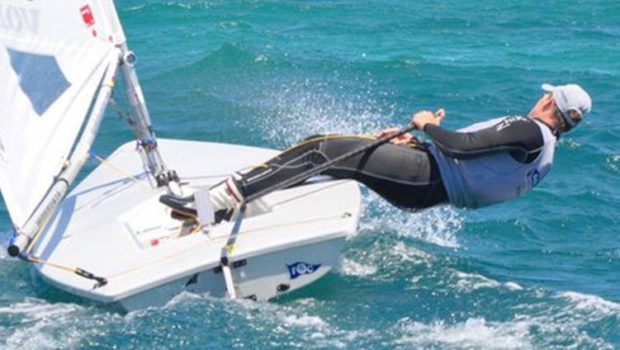So, last week there was not much wind. Most of what we practiced was patience, and getting the boat moving in light breeze.
This week, the plan was to carry out our first sailing drill... "Baby Ducks" which is just follow-the-leader on the water. The goal is simply to carry out whatever maneuvers the Mama Duck (motorboat driven by Coach Hittner) leads into. This gives the coaches control and the ability to observe and make helpful suggestions.
 We already covered all the Points Of Sail, Tacking, and Stopping. We can practice these playing Baby Ducks.
We already covered all the Points Of Sail, Tacking, and Stopping. We can practice these playing Baby Ducks.
Coach Thompson helping two cadets figure out the tangle of running rigging.... which halyard is which?
Before the bus arrives, the coaches have trailered the boats to Lawson Creek, raised the masts, and launched the boats. The first thing the students have to do rig the boats!
What's the very very first thing to do when stepping onto one of our small boats?
This is one of the problems of learning to sail... even a simple thing like getting onto a boat is complicated and may be actually dangerous. But we cannot teach every single tiny detail, it would take forever! So the coaches guide the students thru each evolution, emphasizing safe practices, and making sure the terminology and the actions are clear.
Answer: the very first action after boarding one of our small boats is to lower the centerboard.
 The fun part is LEARNING by DOING!
The fun part is LEARNING by DOING!Hoisting the mainsail... you can see that this is not entirely simple or easy. In this photo you can see Coach Hampstead in his kayak.
Our boats are "sloops" which means they are rigged with one mast, and two sails. Generally the main halyard is on the starboard side of the mainmast, but on a new or unfamiliar boat, one must always double (or triple!) check.
What precautions must be taken, when handling a halyard?
We're getting quicker at rigging up the boats... bending on, and hoisting the sails. This is good because it gives us more sailing time!
Answer: When either end of a halyard is loose (ie not fastened to either the sail or a cleat) it must be held securely and not let loose to fly up & out of reach.
When getting underway, the skipper must observe the wind direction, pick the best course away from the dock, and plan how to get the boat onto the correct Point Of Sail. The crew may cast off, or the skipper may do this himself so the crew can mind other obstacles and handle the jib sheet and balance the boat.
In our case, the coaches cast off and give the sailors a nice push-off from the dock.
What does the crew do immediately after casting off from the dock?
Hint: you can see the rope in question in this photo
These sailors have just gotten clear of the dock, have tacked, and are sailing out toward the coach boat (Mama Duck) to begin proving their skill
.
At this point in the class, we have studied and practiced TACKING (but we need more practice) and we hope to learn the skill of STOPPING... needless to say, sailboats do not have brakes!
Answer: after casting off, the crew must stow the bow line (the rope that held the boat to the dock, and remains fastened to the bow) securely. If it trails in the water under the boat, it can get caught on the centerboard or the rudder, and cause major problems.
For better practice, we have some buoys to sail around. Steering a steady course toward either buoy is not the easiest thing in the world, especially as the boat heels.
Although given instructions to always TACK, some students decided it was more important to sail around the buoys, making it a 50/50 chance they might TACK or go the other way and GYBE.
 We have not studied GYBING yet and the cadets did poorly. However, the wind was relatively kind and no heads got knocked off.
We have not studied GYBING yet and the cadets did poorly. However, the wind was relatively kind and no heads got knocked off.Here is a "Baby Duck" being done poorly. Yes there was a collision, in fact there were a couple of them. So this drill was NOT a passing grade!
This is an excellent beginner sailing exercise. We practiced STOPPING and the cadets learned well.
Among things learned... the crew must keep a good lookout, and make sure the skipper knows about other boats (or any other obstacle) near by. The skipper must think ahead and keep good control of his vessel!
.
Here is an example of a better "Baby Duck" drill. We still have some boats not quite getting the hang of it. At this point, we have practiced two stops (which resulted in boats sailing right past the coach boat, and other boats getting stuck in irons) and two tacks, but the sailors got back in line.
.
Well, the practice in stopping was not totally a wash out. When the time came to sail back to the dock, we had NO crashes! This is a big success, for first-time skippers!
.

So overall, it was a very good sailing session.
Yes there some mistakes, but that is part of how we learn.
We also had a lot of fun and a good time on the water, one of the benefits of living here in New Bern!
.
... posted by Sailing Coach Douglas King
.



















